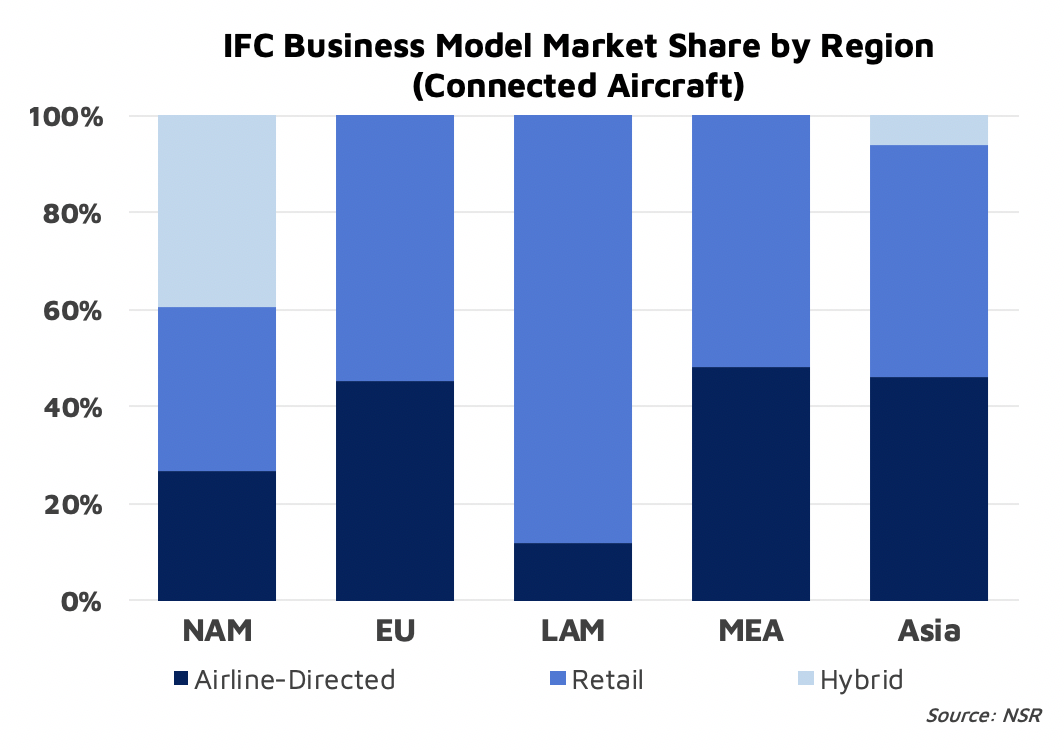Monetizing IFC: The 3rd Party Promise
At the recent Satellite 2019 and the AIX 2019 conferences, there were many discussions centered on enhancing the passenger experience and, in the process, monetizing what is still today relatively low returns on IFC investments by airlines. There have been many promises that passengers themselves would pay for the service (the retail model), but that is still a work-in-progress given the difficulty of simply paying for a session, among other hurdles. For many in the industry, the answer lies in lining up 3rd parties to foot the bill (the ‘hybrid model’) by advertising to passengers or giving Wi-Fi access for free to their flying subscribers. As of now, the ‘hybrid model’ that promised to lift the burden of IFC CAPEX seems to have been met with little success, and the best path forward is still not very clear, but it has a lot of upside in improving the overall passenger experience and the airlines’ bottom line.
In NSR’s Aeronautical Satcom Market, 7th Edition report, future trends in IFC and in particular IFC business models were analyzed. NSR found the 3rd party sponsor (hybrid) model is still nascent and regionally centered on North America. Recent announcements by American Airlines to offer Apple Music on ViaSat-equipped aircraft is one such example where commercial revenue-generation through partnership to improve the ‘customer experience’ raises the bar for IFC. The mantra of ‘My music anywhere, anytime’ is a real need for various groups of travelers, but even more so for today’s biggest growing traveler market, the Millennials. So, that is one way to (partially) offset costs as these subscribers get their Wi-Fi for free or anyone can subscribe to get it for free.
However, this is only part of ‘experience-building’, as an airline representative at Satellite 2019 indicated that personalizing ads is perhaps a must such that what passengers see or hear must be better suited to their needs while in flight or for the places where they are headed. And in turn, they noted Net Promoter Scores (NPS), the measure of customer experience satisfaction and loyalty, improves. This then feeds a virtuous cycle of recurring (and hopefully increasing) revenues.

Will this work everywhere today? It’s not certain but if one looks at IFC retail revenues evolution in the most mature IFC market, North America, it hints at what could happen in other regions as far as development of the still-nascent hybrid model when more airlines use it. The monetization here requires not just the airlines and the service provider’s ideas and platforms to move passengers’ IFC take rates, it also adds other parties’ creativity in generating sources of potential revenues. The hybrid model is utilized on almost 40% of all connected aircraft flying on North American airlines. It is a sure sign of a mature market because 3rd parties such as Amazon, Netflix, and now Apple have been sought and involved more frequently to consider the aircraft as another conduit for their content to reach current or new subscribers.
It is set to improve as, beyond these content providers, the hybrid model is ideal for social media outlets, entertainment providers, retail consumer platforms or even the gaming industry who can maximize the potential for IFC monetization. With travel, business or communications offerings that enhance subscribers’ experience on their service, these “non-IFC” players are close allies in improving airline (or an alliance) loyalty and provide a win-win for both.
Either through exclusivity or via revenue-sharing, various new or improved services are touted, such as personalized maps together with e-commerce, targeted ads, and even local influencer relationships, a much sough-after relay of information for Millennials. Incidentally they also happen to be more laidback on confidential information sharing, which blends in well with the personalization of experience that 3rd parties are looking for in this IFC model.
Bottom Line
As more effortless means are deployed for passengers to get connected on IFC systems, the changes coming to the business models for airline connectivity are aiming at an untapped market, namely the 3rd party. It is not a straight line to go from one click on a social media or viewing an advertisement to raise IFC revenues, but it will help unlock the promise that the hybrid model brings to IFC moving forward.
